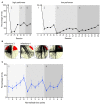A behavioral task for investigating action discovery, selection and switching: comparison between types of reinforcer
- PMID: 25477795
- PMCID: PMC4235381
- DOI: 10.3389/fnbeh.2014.00398
A behavioral task for investigating action discovery, selection and switching: comparison between types of reinforcer
Abstract
Action discovery and selection are critical cognitive processes that are understudied at the cellular and systems neuroscience levels. Presented here is a new rodent joystick task suitable to test these processes due to the range of action possibilities that can be learnt while performing the task. Rats learned to manipulate a joystick while progressing through task milestones that required increasing degrees of movement accuracy. In a switching phase designed to measure action discovery, rats were repeatedly required to discover new target positions to meet changing task demands. Behavior was compared using both food and electrical brain stimulation reward (BSR) of the substantia nigra as reinforcement. Rats reinforced with food and those with BSR performed similarly overall, although BSR-treated rats exhibited greater vigor in responding. In the switching phase, rats learnt new actions to adapt to changing task demands, reflecting action discovery processes. Because subjects are required to learn different goal-directed actions, this task could be employed in further investigations of the cellular mechanisms of action discovery and selection. Additionally, this task could be used to assess the behavioral flexibility impairments seen in conditions such as Parkinson's disease and obsessive-compulsive disorder. The versatility of the task will enable cross-species investigations of these impairments.
Keywords: action; basal ganglia; discovery; joystick; learning; selection; switching.
Figures




References
-
- Barto A. G., Sutton R. S., Anderson C. W. (1983). Neuronlike adaptive elements that can solve difficult learning control-problems. IEEE Trans. Syst. Man Cybern. 13, 834–846 10.1109/TSMC.1983.6313077 - DOI
LinkOut - more resources
Full Text Sources
Other Literature Sources

